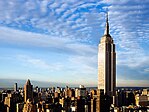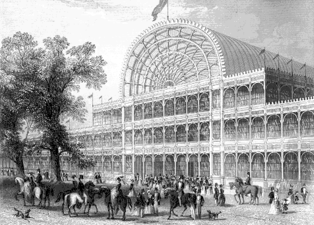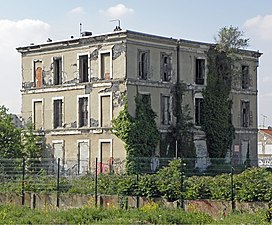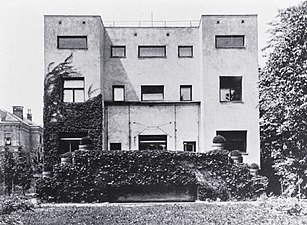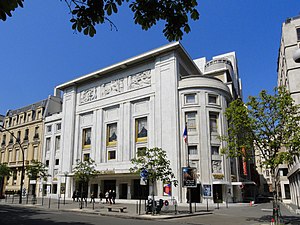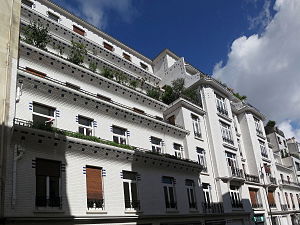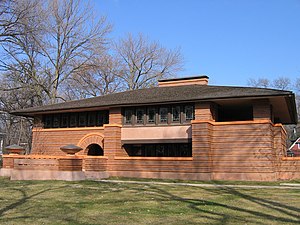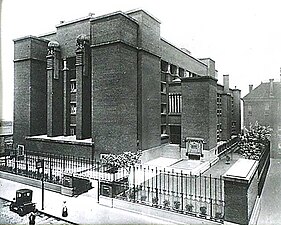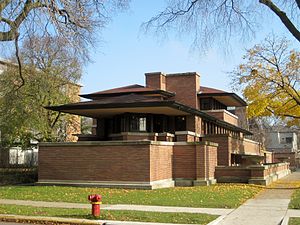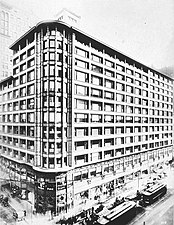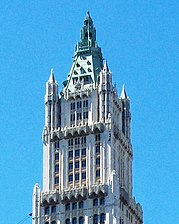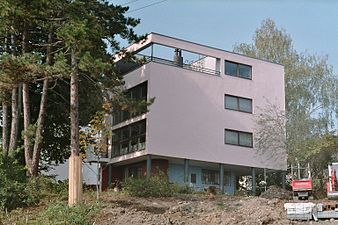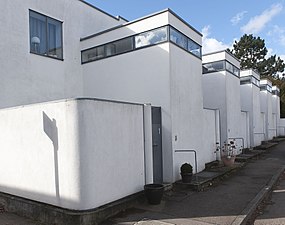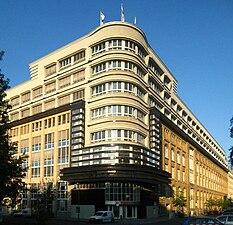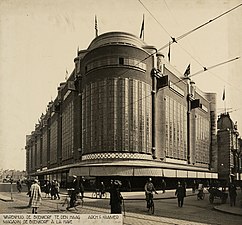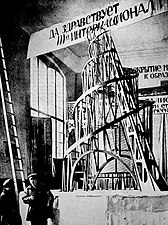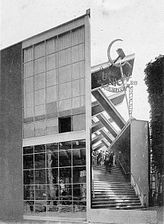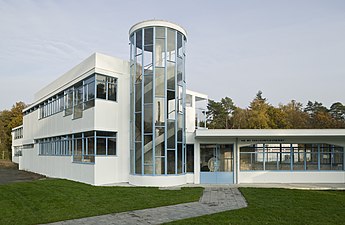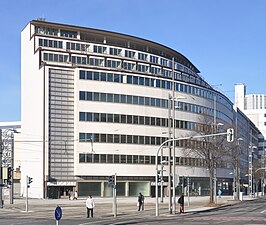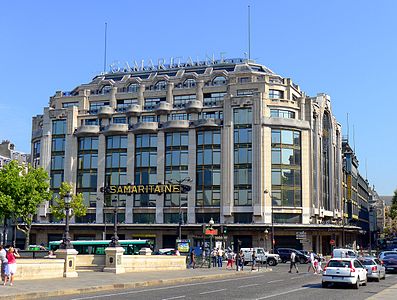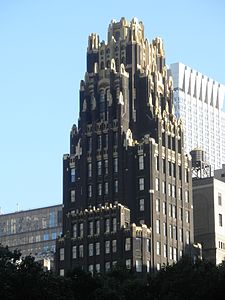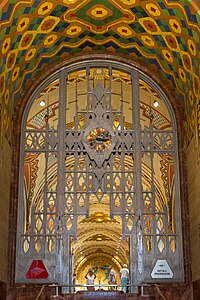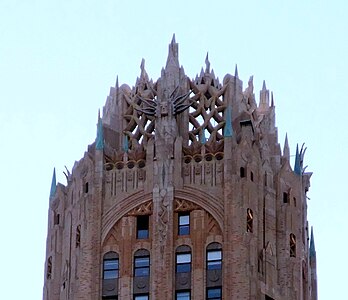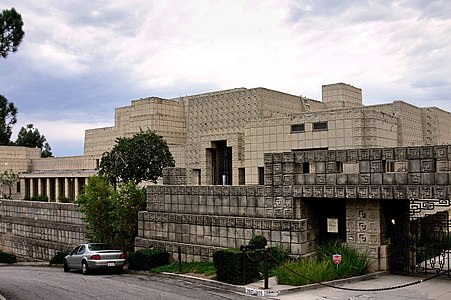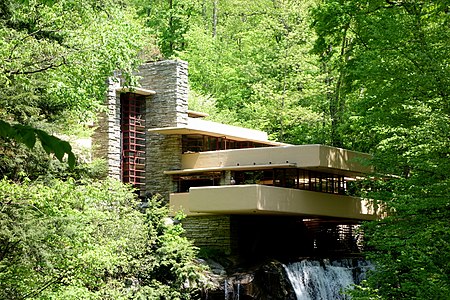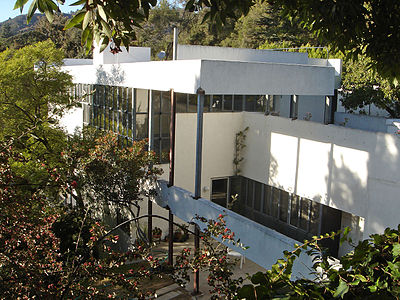
A | B | C | D | E | F | G | H | CH | I | J | K | L | M | N | O | P | Q | R | S | T | U | V | W | X | Y | Z | 0 | 1 | 2 | 3 | 4 | 5 | 6 | 7 | 8 | 9
Top: Villa Savoye, France, by Le Corbusier (1927); Empire State Building, New York, by Shreve, Lamb & Harmon (1931) Center: Palácio do Planalto, Brasilia, by Oscar Niemeyer (1960); Fagus Factory, Germany, by Walter Gropius and Adolf Meyer (1911–1913) Bottom: Fallingwater, Pennsylvania, by Frank Lloyd Wright (1935); Sydney Opera House, Sydney, Australia, by Jørn Utzon (1973) | |
| Years active | 1920s–1980s |
|---|---|
| Location | International |
Modern architecture, also called modernist architecture, was an architectural movement and style that was prominent in the 20th century, between the earlier Art Deco and later postmodern movements. Modern architecture was based upon new and innovative technologies of construction (particularly the use of glass, steel, and concrete); the principle functionalism (i.e. that form should follow function); an embrace of minimalism; and a rejection of ornament.[1]
According to Le Corbusier, the roots of the movement were to be found in the works of Eugène Viollet le duc.[2] The movement emerged in the first half of the 20th century and became dominant after World War II until the 1980s, when it was gradually replaced as the principal style for institutional and corporate buildings by postmodern architecture.[3]
Origins
Modern architecture emerged at the end of the 19th century from revolutions in technology, engineering, and building materials, and from a desire to break away from historical architectural styles and invent something that was purely functional and new.
The revolution in materials came first, with the use of cast iron, drywall, plate glass, and reinforced concrete, to build structures that were stronger, lighter, and taller. The cast plate glass process was invented in 1848, allowing the manufacture of very large windows. The Crystal Palace by Joseph Paxton at the Great Exhibition of 1851 was an early example of iron and plate glass construction, followed in 1864 by the first glass and metal curtain wall. These developments together led to the first steel-framed skyscraper, the ten-story Home Insurance Building in Chicago, built in 1884 by William Le Baron Jenney[4] and based on the works of Viollet le Duc.
French industrialist François Coignet was the first to use iron-reinforced concrete, that is, concrete strengthened with iron bars, as a technique for constructing buildings.[5] In 1853 Coignet built the first iron reinforced concrete structure, a four-storey house in the suburbs of Paris.[5] A further important step forward was the invention of the safety elevator by Elisha Otis, first demonstrated at the New York Crystal Palace exposition in 1854, which made tall office and apartment buildings practical.[6] Another important technology for the new architecture was electric light, which greatly reduced the inherent danger of fires caused by gas in the 19th century.[7]
-
The Berlin Bauakademie, by Karl Friedrich Schinkel (1832–36), is considered one of the forerunners of modern architecture due to its hithertofore relatively streamlined façade of the building
-
The Crystal Palace (1851) was one of the first buildings to have cast plate glass windows supported by a cast-iron frame
-
The first house built of reinforced concrete, designed by François Coignet (1853) in Saint-Denis near Paris
-
The Home Insurance Building in Chicago, by William Le Baron Jenney (1884)
-
The Eiffel Tower being constructed (August 1887–89)
The debut of new materials and techniques inspired architects to break away from the neoclassical and eclectic models that dominated European and American architecture in the late 19th century, most notably eclecticism, Victorian and Edwardian architecture, and the Beaux-Arts architectural style.[8] This break with the past was particularly urged by the architectural theorist and historian Eugène Viollet-le-Duc. In his 1872 book Entretiens sur L'Architecture, he urged: "use the means and knowledge given to us by our times, without the intervening traditions which are no longer viable today, and in that way we can inaugurate a new architecture. For each function its material; for each material its form and its ornament."[9] This book influenced a generation of architects, including Louis Sullivan, Victor Horta, Hector Guimard, and Antoni Gaudí.[10]
Early modernism in Europe (1900–1914)
-
The Glasgow School of Art by Charles Rennie Mackintosh (1896–99)
-
Reinforced concrete apartment building by Auguste Perret, Paris (1903)
-
Austrian Postal Savings Bank in Vienna by Otto Wagner (1904–1906)
-
The AEG Turbine factory in Berlin by Peter Behrens (1909)
-
The Steiner House in Vienna by Adolf Loos, main façade (1910)
-
Stoclet Palace by Josef Hoffmann, Brussels, (1906–1911)
-
The Théâtre des Champs-Élysées in Paris by Auguste Perret (1911–1913)
-
Stepped concrete apartment building in Paris by Henri Sauvage (1912–1914)
-
The Ginsburg skyscraper in Kyiv (1910–1912) by Adolf Minkus and Fyodor Troupianskyi, Europe's tallest building by roof height before 1925.
At the end of the 19th century, a few architects began to challenge the traditional Beaux Arts and Neoclassical styles that dominated architecture in Europe and the United States. The Glasgow School of Art (1896–99) designed by Charles Rennie Mackintosh, had a façade dominated by large vertical bays of windows.[11] The Art Nouveau style was launched in the 1890s by Victor Horta in Belgium and Hector Guimard in France; it introduced new styles of decoration, based on vegetal and floral forms. In Barcelona, Antonio Gaudi conceived architecture as a form of sculpture; the façade of the Casa Batlló in Barcelona (1904–1907) had no straight lines; it was encrusted with colorful mosaics of stone and ceramic tiles.[12]
Architects also began to experiment with new materials and techniques, which gave them greater freedom to create new forms. In 1903–1904 in Paris Auguste Perret and Henri Sauvage began to use reinforced concrete, previously only used for industrial structures, to build apartment buildings.[13] Reinforced concrete, which could be molded into any shape, and which could create enormous spaces without the need of supporting pillars, replaced stone and brick as the primary material for modernist architects. The first concrete apartment buildings by Perret and Sauvage were covered with ceramic tiles, but in 1905 Perret built the first concrete parking garage on 51 rue de Ponthieu in Paris; here the concrete was left bare, and the space between the concrete was filled with glass windows. Henri Sauvage added another construction innovation in an apartment building on Rue Vavin in Paris (1912–1914); the reinforced concrete building was in steps, with each floor set back from the floor below, creating a series of terraces. Between 1910 and 1913, Auguste Perret built the Théâtre des Champs-Élysées, a masterpiece of reinforced concrete construction, with Art Deco sculptural bas-reliefs on the façade by Antoine Bourdelle. Because of the concrete construction, no columns blocked the spectator's view of the stage.[14]
Otto Wagner, in Vienna, was another pioneer of the new style. In his book Moderne Architektur (1895) he had called for a more rationalist style of architecture, based on "modern life".[15] He designed a stylized ornamental metro station at Karlsplatz in Vienna (1888–89), then an ornamental Art Nouveau residence, Majolika House (1898), before moving to a much more geometric and simplified style, without ornament, in the Austrian Postal Savings Bank (1904–1906). Wagner declared his intention to express the function of the building in its exterior. The reinforced concrete exterior was covered with plaques of marble attached with bolts of polished aluminum. The interior was purely functional and spare, a large open space of steel, glass, and concrete where the only decoration was the structure itself.[16]
The Viennese architect Adolf Loos also began removing any ornament from his buildings. His Steiner House, in Vienna (1910), was an example of what he called rationalist architecture; it had a simple stucco rectangular façade with square windows and no ornament. The fame of the new movement, which became known as the Vienna Secession spread beyond Austria. Josef Hoffmann, a student of Wagner, constructed a landmark of early modernist architecture, the Palais Stoclet, in Brussels, in 1906–1911. This residence, built of brick covered with Norwegian marble, was composed of geometric blocks, wings, and a tower. A large pool in front of the house reflected its cubic forms. The interior was decorated with paintings by Gustav Klimt and other artists, and the architect even designed clothing for the family to match the architecture.[17]
In Germany, a modernist industrial movement, Deutscher Werkbund (German Work Federation) had been created in Munich in 1907 by Hermann Muthesius, a prominent architectural commentator. Its goal was to bring together designers and industrialists, to turn out well-designed, high-quality products, and in the process to invent a new type of architecture.[18] The organization originally included twelve architects and twelve business firms, but quickly expanded. The architects include Peter Behrens, Theodor Fischer (who served as its first president), Josef Hoffmann and Richard Riemerschmid.[19] In 1909 Behrens designed one of the earliest and most influential industrial buildings in the modernist style, the AEG turbine factory, a functional monument of steel and concrete. In 1911–1913, Adolf Meyer and Walter Gropius, who had both worked for Behrens, built another revolutionary industrial plant, the Fagus Factory in Alfeld an der Laine, a building without ornament where every construction element was on display. The Werkbund organized a major exposition of modernist design in Cologne just a few weeks before the outbreak of the First World War in August 1914. For the 1914 Cologne exhibition, Bruno Taut built a revolutionary glass pavilion.[20]
Early American modernism (1890s–1914)
-
William H. Winslow House, by Frank Lloyd Wright, River Forest, Illinois (1893–94)
-
The Arthur Heurtley House in Oak Park, Illinois (1902)
-
The Robie House by Frank Lloyd Wright, Chicago (1909)
Frank Lloyd Wright was a highly original and independent American architect who refused to be categorized in any one architectural movement. Like Le Corbusier and Ludwig Mies van der Rohe, he had no formal architectural training. From 1887 to 1893 he worked in the Chicago office of Louis Sullivan, who pioneered the first tall steel-frame office buildings in Chicago, and who famously stated "form follows function".[21] Wright set out to break all the traditional rules. He was particularly famous for his Prairie Houses, including the Winslow House in River Forest, Illinois (1893–94); Arthur Heurtley House (1902) and Robie House (1909); sprawling, geometric residences without decoration, with strong horizontal lines which seemed to grow out of the earth, and which echoed the wide flat spaces of the American prairie. His Larkin Building (1904–1906) in Buffalo, New York, Unity Temple (1905) in Oak Park, Illinois and Unity Temple had highly original forms and no connection with historical precedents.[22]
Early skyscrapers
-
Home Insurance Building in Chicago by William Le Baron Jenney (1883)
-
The Flatiron Building in New York City (1903)
-
The Carson, Pirie, Scott and Company Building in Chicago by Louis Sullivan (1904–1906)
-
The Woolworth Building and the New York skyline in 1913. It was modern on the inside but neo-Gothic on the outside.
-
The neo-Gothic crown of the Woolworth Building by Cass Gilbert (1912)
At the end of the 19th century, the first skyscrapers began to appear in the United States. They were a response to the shortage of land and high cost of real estate in the center of the fast-growing American cities, and the availability of new technologies, including fireproof steel frames and improvements in the safety elevator invented by Elisha Otis in 1852. The first steel-framed "skyscraper", The Home Insurance Building in Chicago, was ten stories high. It was designed by William Le Baron Jenney in 1883, and was briefly the tallest building in the world. Louis Sullivan built another monumental new structure, the Carson, Pirie, Scott and Company Building, in the heart of Chicago in 1904–1906. While these buildings were revolutionary in their steel frames and height, their decoration was borrowed from Neo-Renaissance, Neo-Gothic and Beaux-Arts architecture. The Woolworth Building, designed by Cass Gilbert, was completed in 1912, and was the tallest building in the world until the completion of the Chrysler Building in 1929. The structure was purely modern, but its exterior was decorated with Neo-Gothic ornament, complete with decorative buttresses, arches and spires, which caused it to be nicknamed the "Cathedral of Commerce".[23]
Rise of modernism in Europe and Russia (1918–1931)
After the first World War, a prolonged struggle began between architects who favored the more traditional styles of neo-classicism and the Beaux-Arts architecture style, and the modernists, led by Le Corbusier and Robert Mallet-Stevens in France, Walter Gropius and Ludwig Mies van der Rohe in Germany, and Konstantin Melnikov in the new Soviet Union, who wanted only pure forms and the elimination of any decoration. Louis Sullivan popularized the axiom Form follows function to emphasize the importance of utilitarian simplicity in modern architecture. Art Deco architects such as Auguste Perret and Henri Sauvage often made a compromise between the two, combining modernist forms and stylized decoration.
International Style (1920s–1970s)
-
Corbusier Haus in Weissenhof Estate, Stuttgart, Germany (1927)
-
Citrohan Haus in Weissenhof Estate, Stuttgart, Germany by Le Corbusier (1927)
-
The Villa Savoye in Poissy by Le Corbusier (1928–31)
-
Villa Paul Poiret by Robert Mallet-Stevens (1921–1925)
-
The Villa Noailles in Hyères by Robert Mallet-Stevens (1923)
-
Hôtel Martel rue Mallet-Stevens, by Robert Mallet-Stevens (1926–1927)
The dominant figure in the rise of modernism in France was Charles-Édouard Jeanerette, a Swiss-French architect who in 1920 took the name Le Corbusier. In 1920 he co-founded a journal called 'L'Espirit Nouveau and energetically promoted architecture that was functional, pure, and free of any decoration or historical associations. He was also a passionate advocate of a new urbanism, based on planned cities. In 1922 he presented a design of a city for three million people, whose inhabitants lived in identical sixty-story tall skyscrapers surrounded by open parkland. He designed modular houses, which would be mass-produced on the same plan and assembled into apartment blocks, neighborhoods, and cities. In 1923 he published "Toward an Architecture", with his famous slogan, "a house is a machine for living in."[24] He tirelessly promoted his ideas through slogans, articles, books, conferences, and participation in Expositions.
To illustrate his ideas, in the 1920s he built a series of houses and villas in and around Paris. They were all built according to a common system, based upon the use of reinforced concrete, and of reinforced concrete pylons in the interior which supported the structure, allowing glass curtain walls on the façade and open floor plans, independent of the structure. They were always white, and had no ornament or decoration on the outside or inside. The best-known of these houses was the Villa Savoye, built in 1928–1931 in the Paris suburb of Poissy. An elegant white box wrapped with a ribbon of glass windows around on the façade, with living space that opened upon an interior garden and countryside around, raised up by a row of white pylons in the center of a large lawn, it became an icon of modernist architecture.[25]
Bauhaus and the German Werkbund (1919–1933)
-
The Barcelona Pavilion (modern reconstruction) by Ludwig Mies van der Rohe (1929)
In Germany, two important modernist movements appeared after the first World War, The Bauhaus was a school founded in Weimar in 1919 under the direction of Walter Gropius. Gropius was the son of the official state architect of Berlin, who studied before the war with Peter Behrens, and designed the modernist Fagus turbine factory. The Bauhaus was a fusion of the prewar Academy of Arts and the school of technology. In 1926 it was transferred from Weimar to Dessau; Gropius designed the new school and student dormitories in the new, purely functional modernist style he was encouraging. The school brought together modernists in all fields; the faculty included the modernist painters Vasily Kandinsky, Joseph Albers and Paul Klee, and the designer Marcel Breuer.
Gropius became an important theorist of modernism, writing The Idea and Construction in 1923. He was an advocate of standardization in architecture, and the mass construction of rationally designed apartment blocks for factory workers. In 1928 he was commissioned by the Siemens company to build apartment for workers in the suburbs of Berlin, and in 1929 he proposed the construction of clusters of slender eight- to ten-story high-rise apartment towers for workers.
While Gropius was active at the Bauhaus, Ludwig Mies van der Rohe led the modernist architectural movement in Berlin. Inspired by the De Stijl movement in the Netherlands, he built clusters of concrete summer houses and proposed a project for a glass office tower. He became the vice president of the German Werkbund, and became the head of the Bauhaus from 1930 to 1933. proposing a wide variety of modernist plans for urban reconstruction. His most famous modernist work was the German pavilion for the 1929 international exposition in Barcelona. It was a work of pure modernism, with glass and concrete walls and clean, horizontal lines. Though it was only a temporary structure, and was torn down in 1930, it became, along with Le Corbusier's Villa Savoye, one of the best-known landmarks of modernist architecture. A reconstructed version now stands on the original site in Barcelona.[26]
When the Nazis came to power in Germany, they viewed the Bauhaus as a training ground for communists, and closed the school in 1933. Gropius left Germany and went to England, then to the United States, where he and Marcel Breuer both joined the faculty of the Harvard Graduate School of Design, and became the teachers of a generation of American postwar architects. In 1937 Mies van der Rohe also moved to the United States; he became one of the most famous designers of postwar American skyscrapers.[26]
Expressionist architecture (1918–1931)
-
Foyer of the Großes Schauspielhaus, or Great Theater, in Berlin by Hans Poelzig (1919)
-
The Einstein Tower near Berlin by Erich Mendelsohn (1920–24)
-
The Mossehaus in Berlin by Erich Mendelsohn, an early example of streamline moderne (1921–23)
-
The Chilehaus in Hamburg by Fritz Höger (1921–24)
-
Horseshoe Estate public housing project by Bruno Taut (1925)
-
Second Goetheanum in Dornach near Basel (Switzerland) by the Austrian architect Rudolf Steiner (1924–1928)
Expressionism, which appeared in Germany between 1910 and 1925, was a counter-movement against the strictly functional architecture of the Bauhaus and Werkbund. Its advocates, including Bruno Taut, Hans Poelzig, Fritz Hoger and Erich Mendelsohn, wanted to create architecture that was poetic, expressive, and optimistic. Many expressionist architects had fought in World War I and their experiences, combined with the political turmoil and social upheaval that followed the German Revolution of 1919, resulted in a utopian outlook and a romantic socialist agenda.[27] Economic conditions severely limited the number of built commissions between 1914 and the mid-1920s,[28] As result, many of the most innovative expressionist projects, including Bruno Taut's Alpine Architecture and Hermann Finsterlin's Formspiels, remained on paper. Scenography for theatre and films provided another outlet for the expressionist imagination,[29] and provided supplemental incomes for designers attempting to challenge conventions in a harsh economic climate. A particular type, using bricks to create its forms (rather than concrete) is known as Brick Expressionism.
Erich Mendelsohn, (who disliked the term Expressionism for his work) began his career designing churches, silos, and factories which were highly imaginative, but, for lack of resources, were never built. In 1920, he finally was able to construct one of his works in the city of Potsdam; an observatory and research center called the Einsteinium, named in tribute to Albert Einstein. It was supposed to be built of reinforced concrete, but because of technical problems it was finally built of traditional materials covered with plaster. His sculptural form, very different from the austere rectangular forms of the Bauhaus, first won him commissions to build movie theaters and retail stores in Stuttgart, Nuremberg, and Berlin. His Mossehaus in Berlin was an early model for the streamline moderne style. His Columbushaus on Potsdamer Platz in Berlin (1931) was a prototype for the modernist office buildings that followed. (It was torn down in 1957, because it stood in the zone between East and West Berlin, where the Berlin Wall was constructed.) Following the rise of the Nazis to power, he moved to England (1933), then to the United States (1941).[30]
Fritz Höger was another notable Expressionist architect of the period. His Chilehaus was built as the headquarters of a shipping company, and was modeled after a giant steamship, a triangular building with a sharply pointed bow. It was constructed of dark brick, and used external piers to express its vertical structure. Its external decoration borrowed from Gothic cathedrals, as did its internal arcades. Hans Poelzig was another notable expressionist architect. In 1919 he built the Großes Schauspielhaus, an immense theater in Berlin, seating five thousand spectators for theater impresario Max Reinhardt. It featured elongated shapes like stalagmites hanging down from its gigantic dome, and lights on massive columns in its foyer. He also constructed the IG Farben building, a massive corporate headquarters, now the main building of Goethe University in Frankfurt. Bruno Taut specialized in building large-scale apartment complexes for working-class Berliners. He built twelve thousand individual units, sometimes in buildings with unusual shapes, such as a giant horseshoe. Unlike most other modernists, he used bright exterior colors to give his buildings more life The use of dark brick in the German projects gave that particular style a name, Brick Expressionism.[31]
The Austrian philosopher, architect, and social critic Rudolf Steiner also departed as far as possible from traditional architectural forms. His Second Goetheanum, built from 1926 near Basel, Switzerland and Mendelsohn's Einsteinturm in Potsdam, Germany, were based on no traditional models and had entirely original shapes.
Constructivist architecture (1919–1931)
-
Model of the Tower for the Third International, by Vladimir Tatlin (1919)
-
The Lenin Mausoleum in Moscow by Alexey Shchusev (1924)
-
The USSR Pavilion at the 1925 Paris Exposition of Decorative Arts, by Konstantin Melnikov (1925)
-
Rusakov Workers' Club, Moscow, by Konstantin Melnikov (1928)
-
Open air school in Amsterdam by Jan Duiker (1929–1930)
After the Russian Revolution of 1917, Russian avant-garde artists and architects began searching for a new Soviet style which could replace traditional neoclassicism. The new architectural movements were closely tied with the literary and artistic movements of the period, the futurism of poet Vladimir Mayakovskiy, the Suprematism of painter Kasimir Malevich, and the colorful Rayonism of painter Mikhail Larionov. The most startling design that emerged was the tower proposed by painter and sculptor Vladimir Tatlin for the Moscow meeting of the Third Communist International in 1920: he proposed two interlaced towers of metal four hundred meters high, with four geometric volumes suspended from cables. The movement of Russian Constructivist architecture was launched in 1921 by a group of artists led by Aleksandr Rodchenko. Their manifesto proclaimed that their goal was to find the "communist expression of material structures". Soviet architects began to construct workers' clubs, communal apartment houses, and communal kitchens for feeding whole neighborhoods.[32]
One of the first prominent constructivist architects to emerge in Moscow was Konstantin Melnikov, the number of working clubs – including Rusakov Workers' Club (1928) – and his own living house, Melnikov House (1929) near Arbat Street in Moscow. Melnikov traveled to Paris in 1925 where he built the Soviet Pavilion for the International Exhibition of Modern Decorative and Industrial Arts in Paris in 1925; it was a highly geometric vertical construction of glass and steel crossed by a diagonal stairway, and crowned with a hammer and sickle. The leading group of constructivist architects, led by Vesnin brothers and Moisei Ginzburg, was publishing the 'Contemporary Architecture' journal. This group created several major constructivist projects in the wake of the First Five Year Plan – including colossal Dnieper Hydroelectric Station (1932) – and made an attempt to start the standardization of living blocks with Ginzburg's Narkomfin building. A number of architects from the pre-Soviet period also took up the constructivist style. The most famous example was Lenin's Mausoleum in Moscow (1924), by Alexey Shchusev (1924)[33]
The main centers of constructivist architecture were Moscow and Leningrad; however, during the industrialization many constructivist buildings were erected in provincial cities. The regional industrial centers, including Ekaterinburg, Kharkiv or Ivanovo, were rebuilt in the constructivist manner; some cities, like Magnitogorsk or Zaporizhzhia, were constructed anew (the so-called socgorod, or 'socialist city').
The style fell markedly out of favor in the 1930s, replaced by the more grandiose nationalist styles that Stalin favored. Constructivist architects and even Le Corbusier projects for the new Palace of the Soviets from 1931 to 1933, but the winner was an early Stalinist building in the style termed Postconstructivism. The last major Russian constructivist building, by Boris Iofan, was built for the Paris World Exhibition (1937), where it faced the pavilion of Nazi Germany by Hitler's architect Albert Speer.[34]
New Objectivity (1920–1933)
-
Heimatsiedlung in Frankfurt an Main by Franz Roeckle (1927–1934)
-
Apartment house in Stuttgart by Mies van der Rohe (1927)
-
Flats in Berlin's Prenzlauer Berg by Bruno Taut (1920s)
-
Flats in Siemensstadt, Berlin, by Hans Scharoun (early 1930s)
-
Former Schocken Department Store, Chemnitz, by Erich Mendelsohn (1927-1930)
The New Objectivity (in German Neue Sachlichkeit, sometimes also translated as New Sobriety) is a name often given to the Modern architecture that emerged in Europe, primarily German-speaking Europe, in the 1920s and 30s. It is also frequently called Neues Bauen (New Building). The New Objectivity took place in many German cities in that period, for example in Frankfurt with its Neues Frankfurt project.
Modernism becomes a movement: CIAM (1928)
By the late 1920s, modernism had become an important movement in Europe. Architecture, which previously had been predominantly national, began to become international. The architects traveled, met each other, and shared ideas. Several modernists, including Le Corbusier, had participated in the competition for the headquarters of the League of Nations in 1927. In the same year, the German Werkbund organized an architectural exposition at the Weissenhof Estate Stuttgart. Seventeen leading modernist architects in Europe were invited to design twenty-one houses; Le Corbusier, and Ludwig Mies van der Rohe played a major part. In 1927 Le Corbusier, Pierre Chareau, and others proposed the foundation of an international conference to establish the basis for a common style. The first meeting of the Congrès Internationaux d'Architecture Moderne or International Congresses of Modern Architects (CIAM), was held in a chateau on Lake Leman in Switzerland 26–28 June 1928. Those attending included Le Corbusier, Robert Mallet-Stevens, Auguste Perret, Pierre Chareau and Tony Garnier from France; Victor Bourgeois from Belgium; Walter Gropius, Erich Mendelsohn, Ernst May and Ludwig Mies van der Rohe from Germany; Josef Frank from Austria; Mart Stam and Gerrit Rietveld from the Netherlands, and Adolf Loos from Czechoslovakia. A delegation of Soviet architects was invited to attend, but they were unable to obtain visas. Later members included Josep Lluís Sert of Spain and Alvar Aalto of Finland. No one attended from the United States. A second meeting was organized in 1930 in Brussels by Victor Bourgeois on the topic "Rational methods for groups of habitations". A third meeting, on "The functional city", was scheduled for Moscow in 1932, but was cancelled at the last minute. Instead, the delegates held their meeting on a cruise ship traveling between Marseille and Athens. On board, they together drafted a text on how modern cities should be organized. The text, called The Athens Charter, after considerable editing by Corbusier and others, was finally published in 1957 and became an influential text for city planners in the 1950s and 1960s. The group met once more in Paris in 1937 to discuss public housing and was scheduled to meet in the United States in 1939, but the meeting was cancelled because of the war. The legacy of the CIAM was a roughly common style and doctrine which helped define modern architecture in Europe and the United States after World War II.[35]
Art Deco
-
Pavilion of the Galeries Lafayette Department Store at the Paris International Exposition of Decorative Arts (1925)
-
La Samaritaine department store, by Henri Sauvage, Paris, (1925–28)
The Art Deco architectural style (called Style Moderne in France), was modern, but it was not modernist; it had many features of modernism, including the use of reinforced concrete, glass, steel, chrome, and it rejected traditional historical models, such as the Beaux-Arts style and Neo-classicism; but, unlike the modernist styles of Le Corbusier and Mies van der Rohe, it made lavish use of decoration and color. It reveled in the symbols of modernity; lightning flashes, sunrises, and zig-zags. Art Deco had begun in France before World War I and spread through Europe; in the 1920s and 1930s it became a highly popular style in the United States, South America, India, China, Australia, and Japan. In Europe, Art Deco was particularly popular for department stores and movie theaters. The style reached its peak in Europe at the International Exhibition of Modern Decorative and Industrial Arts in 1925, which featured art deco pavilions and decoration from twenty countries. Only two pavilions were purely modernist; the Esprit Nouveau pavilion of Le Corbusier, which represented his idea for a mass-produced housing unit, and the pavilion of the USSR, by Konstantin Melnikov in a flamboyantly futurist style.[36]
Later French landmarks in the Art Deco style included the Grand Rex movie theater in Paris, La Samaritaine department store by Henri Sauvage (1926–28) and the Social and Economic Council building in Paris (1937–38) by Auguste Perret, and the Palais de Tokyo and Palais de Chaillot, both built by collectives of architects for the 1937 Paris Exposition Internationale des Arts et Techniques dans la Vie Moderne.[37]
American Art Deco; the skyscraper style (1919–1939)
-
The American Radiator Building in New York City by Raymond Hood (1924)
-
Guardian Building in Detroit, by Wirt C. Rowland (1927–29)
-
Chrysler Building in New York City, by William Van Alen (1928–30)
-
Crown of the General Electric Building (also known as 570 Lexington Avenue) by Cross & Cross (1933)
-
30 Rockefeller Center, now the Comcast Building, by Raymond Hood (1933)
In the late 1920s and early 1930s, an exuberant American variant of Art Deco appeared in the Chrysler Building, Empire State Building and Rockefeller Center in New York City, and Guardian Building in Detroit. The first skyscrapers in Chicago and New York had been designed in a neo-gothic or neoclassical style, but these buildings were very different; they combined modern materials and technology (stainless steel, concrete, aluminum, chrome-plated steel) with Art Deco geometry; stylized zig-zags, lightning flashes, fountains, sunrises, and, at the top of the Chrysler building, Art Deco "gargoyles" in the form of stainless steel radiator ornaments. The interiors of these new buildings, sometimes termed Cathedrals of Commerce", were lavishly decorated in bright contrasting colors, with geometric patterns variously influenced by Egyptian and Mayan pyramids, African textile patterns, and European cathedrals, Frank Lloyd Wright himself experimented with Mayan Revival, in the concrete cube-based Ennis House of 1924 in Los Angeles. The style appeared in the late 1920s and 1930s in all major American cities. The style was used most often in office buildings, but it also appeared in the enormous movie palaces that were built in large cities when sound films were introduced.[38]
Streamline style and Public Works Administration (1933–1939)
-
Pan-Pacific Auditorium in Los Angeles (1936)
-
The San Francisco Maritime Museum, originally was a public bathhouse (1936)
-
Intake towers of Hoover Dam (1931–36)
-
Long Beach Main Post Office (1933–34)
The beginning of the Great Depression in 1929 brought an end to lavishly decorated Art Deco architecture and a temporary halt to the construction of new skyscrapers. It also brought in a new style, called "Streamline Moderne" or sometimes just Streamline. This style, sometimes modeled after for the form of ocean liners, featured rounded corners, strong horizontal lines, and often nautical features, such as superstructures and steel railings. It was associated with modernity and especially with transportation; the style was often used for new airport terminals, train and bus stations, and for gas stations and diners built along the growing American highway system. In the 1930s the style was used not only in buildings, but in railroad locomotives, and even refrigerators and vacuum cleaners. It both borrowed from industrial design and influenced it.[39]
In the United States, the Great Depression led to a new style for government buildings, sometimes called PWA Moderne, for the Public Works Administration, which launched gigantic construction programs in the U.S. to stimulate employment. It was essentially classical architecture stripped of ornament, and was employed in state and federal buildings, from post offices to the largest office building in the world at that time, Pentagon (1941–43), begun just before the United States entered the Second World War.[40]
American modernism (1919–1939)
-
Ennis House in Los Angeles, by Frank Lloyd Wright (1924)
-
Fallingwater by Frank Lloyd Wright (1928–34)
-
Lovell Health House in Los Feliz, Los Angeles, California, by Richard Neutra (1927–29)
During the 1920s and 1930s, Frank Lloyd Wright resolutely refused to associate himself with any architectural movements. He considered his architecture to be entirely unique and his own. Between 1916 and 1922, he broke away from his earlier prairie house style and worked instead on houses decorated with textured blocks of cement; this became known as his "Mayan style", after the pyramids of the ancient Mayan civilization. He experimented for a time with modular mass-produced housing. He identified his architecture as "Usonian", a combination of USA, "utopian" and "organic social order". His business was severely affected by the beginning of the Great Depression that began in 1929; he had fewer wealthy clients who wanted to experiment. Between 1928 and 1935, he built only two buildings: a hotel near Chandler, Arizona, and the most famous of all his residences, Fallingwater (1934–37), a vacation house in Pennsylvania for Edgar J. Kaufman. Fallingwater is a remarkable structure of concrete slabs suspended over a waterfall, perfectly uniting architecture and nature.[41]
The Austrian architect Rudolph Schindler designed what could be called the first house in the modern style in 1922, the Schindler house. Schindler also contributed to American modernism with his design for the Lovell Beach House in Newport Beach. The Austrian architect Richard Neutra moved to the United States in 1923, worked for a short time with Frank Lloyd Wright, also quickly became a force in American architecture through his modernist design for the same client, the Lovell Health House in Los Angeles. Neutra's most notable architectural work was the Kaufmann Desert House in 1946, and he designed hundreds of further projects.[42]
Paris International Exposition of 1937 and the architecture of dictators
-
The Palais de Chaillot by Louis-Hippolyte Boileau, Jacques Carlu and Léon Azéma from the 1937 Paris International Exposition
Zdroj:https://en.wikipedia.org?pojem=Modern_architecture
Text je dostupný za podmienok Creative Commons Attribution/Share-Alike License 3.0 Unported; prípadne za ďalších podmienok. Podrobnejšie informácie nájdete na stránke Podmienky použitia.
Antropológia
Aplikované vedy
Bibliometria
Dejiny vedy
Encyklopédie
Filozofia vedy
Forenzné vedy
Humanitné vedy
Knižničná veda
Kryogenika
Kryptológia
Kulturológia
Literárna veda
Medzidisciplinárne oblasti
Metódy kvantitatívnej analýzy
Metavedy
Metodika
Text je dostupný za podmienok Creative
Commons Attribution/Share-Alike License 3.0 Unported; prípadne za ďalších
podmienok.
Podrobnejšie informácie nájdete na stránke Podmienky
použitia.
www.astronomia.sk | www.biologia.sk | www.botanika.sk | www.dejiny.sk | www.economy.sk | www.elektrotechnika.sk | www.estetika.sk | www.farmakologia.sk | www.filozofia.sk | Fyzika | www.futurologia.sk | www.genetika.sk | www.chemia.sk | www.lingvistika.sk | www.politologia.sk | www.psychologia.sk | www.sexuologia.sk | www.sociologia.sk | www.veda.sk I www.zoologia.sk


